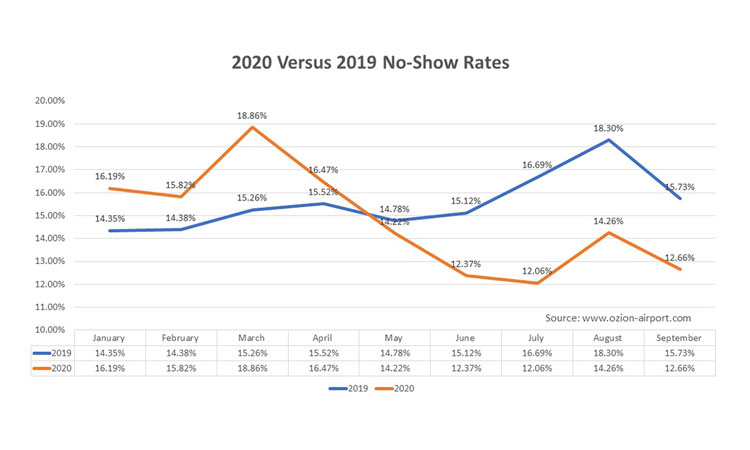Modern IT drives cost efficiency in PRM assistance
- Like
- Digg
- Del
- Tumblr
- VKontakte
- Buffer
- Love This
- Odnoklassniki
- Meneame
- Blogger
- Amazon
- Yahoo Mail
- Gmail
- AOL
- Newsvine
- HackerNews
- Evernote
- MySpace
- Mail.ru
- Viadeo
- Line
- Comments
- Yummly
- SMS
- Viber
- Telegram
- Subscribe
- Skype
- Facebook Messenger
- Kakao
- LiveJournal
- Yammer
- Edgar
- Fintel
- Mix
- Instapaper
- Copy Link
Posted: 18 June 2021 | Roberto Castiglioni | No comments yet
Accessible Air Travel Expert, Roberto Castiglioni, speaks to International Airport Review about the impact that PRM no-shows have on operational efficiency and what airports can do to tackle this.


One of the few positives of the COVID-19 pandemic was to allow time for airport operators to perform in-depth analysis of passengers with reduced mobility (PRM) data, identify problems and close gaps. It is a given that the road to recovery in certain areas of the world will hardly be as fast as we would all like. International travel and certain domestic routes will remain affected by the lack of coordination of national health requirements for a while.
In this scenario, now more than ever before, every penny matters, and every available human resource must work at full capacity. It is never pleasant, or easy, to talk about understaffing, but the current state of affairs leaves little room for optimism. In this view, managing human resources efficiently will be of pivotal importance not only to drive efficiencies, but, more importantly, to guarantee quality of service output.
One of the few positives of the COVID-19 pandemic was to allow time for airport operators to perform in-depth analysis of passengers with reduced mobility (PRM) data, identify problems and close gaps. It is a given that the road to recovery in certain areas of the world will hardly be as fast as we would all like. International travel and certain domestic routes will remain affected by the lack of coordination of national health requirements for a while.
In this scenario, now more than ever before, every penny matters, and every available human resource must work at full capacity. It is never pleasant, or easy, to talk about understaffing, but the current state of affairs leaves little room for optimism. In this view, managing human resources efficiently will be of pivotal importance not only to drive efficiencies, but, more importantly, to guarantee quality of service output.
PRM no-shows
A few months back, OZION Airport Software published an intriguing report on PRM no-shows. For those non-accustomed to this concept, a no-show happens when a pre-booked PRM does not report to assistance staff on arrival. The booking is confirmed by the airline via PAL/CAL messaging, and a member of staff is allocated to the job.
No-shows can happen for a number of reasons, the most common being the airport of arrival is not as large as the one of departure and, therefore, assistance may not be required due to shorter distances. Clearly, the vast majority of no-shows happen with pre-booked wheelchair assistance.


OZION report showing analysis of no-show data from five airports in 2019 and 2020.
Copyright: OZION Airport Software
Going back to the OZION report, analysis of data from five airports showed a slight improvement in 2020 over 2019. But, when we look at 2019, we clearly see no-shows hovering at around 16 per cent of all pre-booked assistance requests.
This is an eye-watering number. Of all requests, 16 per cent are not performed because of a no‑show. Let us now think of the massive waste that this phenomenon generates in terms of resource allocation and related costs.
The cost is clear: operators are billed for services not provided. Truth be told, resources are booked and allocated to jobs that will not materialise. There is an equally important impact that no‑shows have on the overall performance of assistance services; at peak times, when resources are already stretched, allocating staff to jobs that will not occur has an impact on the waiting times of other passengers requiring assistance.
How can industry tackle this costly problem?
A dual approach
On the one hand, it is essential to allow passengers the option to book assistance where it is needed. The way that systems are currently designed only allow for a single input comprehensive request: if you book assistance, the request will be automatically sent at both ends of the journey.
Hoping that special service request (SSR) Free Text messages can be the solution is naïve at best. It would require the constant monitoring of Free Text for all requests. Perhaps a viable approach at times of slow traffic, but unrealistic at peak traffic times.
Alternatively, constant data pruning between PAL/CAL requests and passenger service messages (PSM) could help to mitigate the problem. However, there is no guarantee that the PSM also reports requests for assistance that will eventually become a no-show because of the passenger’s knowledge of the built environment.
Therefore, the only sensible and permanent solution at the booking stage is to modify systems to reflect the availability to request assistance at only one touchpoint: either departure or arrival. I am not a programmer, but an independent software programmer recently told me that the cost of this change to current IT frameworks is fractional and, given the size of this phenomenon, return on investment would be almost immediate.
Real-time information and live data
The other area requiring intervention is the airport PRM software. To better understand the issue, we should take a look at how this solution was born. Up until around 15 years ago, pen and paper were the preferred way to handle assistance requests. In those times, airlines were fully in charge of the provision of this service, so whichever means of internal communication would do.
It was only when EC1107/2006 came into force around 2008 that a different solution had to be found to meet the new challenge that the legal framework created by splitting the responsibility for the provision of assistance between airports and airlines. A technical means for transferring information across the different touchpoints was initially found by modifying existing baggage handling IT solutions.
But PRM assistance is far more sophisticated than baggage handling. Approximately six years ago, modern purpose-built software came to the market.
These new solutions introduced functions that, when used to their maximum extent, help to reduce costs dramatically. For example, real-time information allows for operators to monitor service output performance and highlight areas where deviation to planning may create the misallocation of staff. This translates in increased efficiency of service output.
Multi-stakeholder access to real-time information and live data allows airlines to make decisions that directly impact on-time performance (OTP).
Effortless access to data and data processing in real-time allows operators to immediately identify negative patterns that ultimately affect the bottom line. In our case, data analysis of no-shows allows operators to identify patterns within certain points of origin or on particular flights.
It is perhaps unusual to read these thoughts from an accessibility advocate. But, unlike campaigners, I have always worked at understanding gaps and working with the industry to permanently remove them. Demanding the provision of good service without understanding its costs almost always results in window dressing. But PRM assistance requests continue to grow at a faster pace than mainstream passenger traffic growth, which means that the financial impact of this fundamental service will become unsustainable unless structural changes are found.
The end game is to ensure good service quality output at any given time, especially at times like these, when financial resources are thinner than thin.
I think that the current pandemic presents the excellent opportunity to overhaul the foundations of PRM assistance. Modern IT is the shortcut to provide good service by optimising the underlying processes and procedures. Waste areas like no-shows can easily be driven down to fractions by intervening on both ends; both the booking stage and the handling of the service at the point of provision.
It is true that talking about investments when the bedsheets are too short sounds bizarre. But the opportunity of an almost immediate return on investment is too tempting to pass, and the alternative is as unappealing as it can get – financial unsustainability.


Issue
Related topics
Accessibility, Passenger experience and seamless travel, Passengers with reduced mobility (PRMs)


















